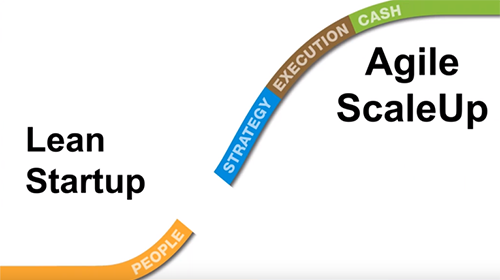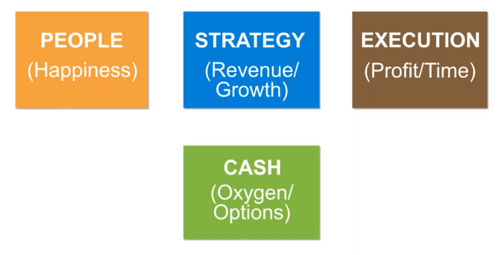4 Key Decisions To Scale A Mid-market Company

In the early 70’s, my father lost his business. I remember the devastating impact it had on him. I remember how hard it was on our family.
I want to make sure this never happens to other business leaders. That’s why I’ve dedicated my life to doing everything I can to support business leaders with the knowledge and resources they need to keep their businesses growing, and thriving.
For the past three decades, I have helped thousands of companies scale up as the founder and CEO of Gazelles, a global executive education coaching company with over 200 partners on six continents.
Recently, I wanted to find out and address the biggest pain point business leaders of mid-market companies in the current market face. So the Growth Institute team conducted a survey with over 1,000 business leaders, and the biggest, burning question we heard from many CEOs and top executives of mid-market companies was:
“How can I really grow my company without losing control of my life?”
To answer this question, I hosted a live webinar training. In case you missed it, here’s a summary of the highlights and biggest insights shared during the training.
3 Qualities Of Leadership To Scale
Did you know there are 11,000 new companies starting up every hour around the globe? The fact is, many companies start up but too few scale up.
The most important foundation to scale a company is having the right leadership. Here are three important qualities business leaders need to have to lead their company into growth.
A. Passion
Let’s take a different view on passion by turning to a book by Marcus Buckingham, “Go Put Your Strengths To Work”. This book was pivotal in helping me understand what I, as a leader, needed to personally focus on to scale up my companies.
The key takeaway from this book is in how Marcus redefines strengths. Many people define strengths as what they’re good at, and because they’re good at many things it becomes difficult for them to let go or delegate. This keeps them stuck because there’s no way any company can scale without other people.
Marcus takes a different approach. He defines strengths as something that gives you energy while you’re doing it and even after you’ve done it. While a weakness is something that wears you out, even if you’re good at it.
The key is to delegate things that deplete you to someone who enjoys that task; to someone whose strength is in that area. Steve Jobs is a great example. Even though he was the CEO, he chaired just the marketing functions because he was really passionate about the design aspect of Apple.
How can you implement this in your company? I’ve identified three steps to guide you in putting your strengths to work:
- For the next few weeks, keep track of all the activities you do on a daily and weekly basis.
- From this list, start eliminating activities that nobody needs to do and identifying activities which can be automated.
- From the remaining tasks, identify the ones that make you tired and then delegate them to someone whose strengths lie in that area.
This process encapsulates one of the main ideas Marcus pushes forward in his book, which I love: Good leaders play checkers, great leaders play chess.
When hiring people and building your team, it’s important you’re not just duplicating yourself like a checkers board where every piece is the same. As a great leader, you want to develop a chess board where unique pieces have different strengths that are able to balance each other and work together as you scale.
B. Purpose
Purpose gives you a bigger reason to scale your company than just the money. One of my favourite thought leaders, Aubrey Daniels, says that if you can touch people’s hearts, you can boost discretionary effort of your team by up to 40%. This gives you a huge competitive advantage, and a huge reason why purpose is so critical for mid-market companies to scale.
An example of a company that exhibits this is Starbucks. They understand that their purpose is bigger than just selling coffee. Rather, their purpose is to be a sanctuary for people between their office and their homes.
C. Persistence
Apple started in 1976, and while they had early success it was only after about 25 years that they really took off. Starbucks only had 100 stores on their 20th anniversary, and their real scale up occurred after their 25th anniversary. Of the top 10 paintings critics consider to be Picasso’s best works, six of them were painted after he was 50 years old.
We are absolutely innovative in our 20s, but we are twice that in our 50s and beyond and a lot of us are just hitting our stride. So persistence is a key ingredient in scaling and becoming our best.
From Starting Up To Scaling Up
Here’s one of the most important things to understand about scaling up a business:
“What got you here, won’t get you there.”

The gap between “startup” and “scale up” is the chasm that Geoffrey Moore, an American organizational theorist, management consultant and author, describes in his work, “Crossing the Chasm”. To cross this chasm, you need to change your strategy, because as mentioned earlier — what got you here, won’t get you there.
In the early days of running a company, you had to say “yes” to everything. Now, you have to start saying “no”. It’s all about tightening up your strategy. Those who have strategy will say “no” more times than they say “yes”. Those who don’t have a strategy will say “yes” to everything.
If you don’t nail strategy, your gross margin dollars will not grow as fast as you would like them to and your execution is not going to be as effective at driving profit and valuation.
The number one job of our strategy is to make things easy for our customers and their customers. Here are a few examples of companies who do this right:
- Amazon looks at how to make it easier to buy products from their site. They even look at how to make their packaging easier to open and better for the environment.
- BajaBound.com makes it easy for their customers to get the auto insurance they need to drive from the U.S. into Mexico. They dominate their niche and has more market share than any of their competitors combined with just seven employees.
- Ikea acquired TaskRabbit so they could make it easier for the elderly to get the furniture and get it assembled.
Another aspect is making things easier for your employees, and this is the true essence of the Scaling Up methodology. It’s to make things easier for you and your employees, so you can scale up without the drama normally associated with growing businesses.
Case Study: Appletree Answers
John Ratliff studied the Scaling Up methodology and implemented it in 2006 as CEO of Appletree Answers. It’s a call centre business, which is in an industry typified by an employee turnover rate of about 200% who on average last for about six months.
Through the Scaling Up methodology and tools that made things easier for his employees, John was able to take that figure down to an industry record-setting 18%. Plus, in an industry averaging 4% in profitability, John was able to achieve 67% in gross margins and net 21% — which was better than Apple’s profitability last year.
Read more on John Ratliff’s experience with the Scaling Up methodology here >>
Let’s now take a look into the different tools in the Scaling Up methodology that will help you make things easier not just for your customers, but also for you and your employees so you can scale up.
Vision Summary
The vision summary is what you really want to share with the bulk of your employees, and maybe even your customers and marketplace. The vision summary has three components:
- The four decisions:
- Core values
- Purpose
- Brand Values
- BHAG - The strategic priorities:
- 3-5 years
- 1 year
- Quarter - Contribution
- KPIs
- Goals
- Quarterly priorities
To do this, there are four decisions that you have to nail, and that’s what I’m going to dive deep into now.
The Four Decisions
The four decisions lie in four areas critical for business growth:
Most of you are aware that managing these four areas in business is like juggling four balls. If you want to scale them, which is getting them higher, then you have to do it one ball at a time. So, the first thing you want to do with your team is to figure out which of these four areas do you need to focus on first, to make things easier for everyone.
Case Study: AlignSpace
After John Ratliff sold Appletree Answers, he started AlignSpace, a co-working space in West Chester, Pennsylvania for scaleups to interact with each other and work on strategy.
He bought an old bank in West Chester to turn into the co-working space, but during the construction and renovation of the office space things began to turn sour really fast. Friction was beginning to form between the construction team and the design team, everyone was frustrated, the project was falling behind schedule, and they were going over the budget.
John realized he needed to focus on his people. So he implemented the daily huddle, which is one of the tools in the Scaling Up methodology, between the construction and design teams. During these huddles, they would discuss their KPIs, what was spent and what they plan to spend for the day. Most importantly, they talked about their biggest constraint of the day and what’s in the way of making progress.
These daily huddles ironed out a lot of miscommunication and helped things move faster since people were no longer stalling because they thought they needed someone to make a decision. In other words, the daily huddles helped to avoid those minor train wrecks that would make people’s tasks harder and make them unhappy.
In the end, they finished ahead of schedule and launched a beautiful 3-story space. John credits the daily huddle for helping to manage the chaos between the construction and design teams.
Now, let’s look into scaling up each area of growth.
Scaling Up People
A lot of mid-market companies could at least double their revenues with the headcount they have today, without having to attract more talent.
A a lot of us are so focused on wanting a great sales team, a great marketing team, a great HR team, a great IT team, and so on. We then tend to forget that the real work occurs cutting across those functions in a series of four to nine processes. To do that, you've got to be clear who is accountable for what, and you’ve got to know whether they’re running it well.
I have designed a few tools to help you scale up the “people” area of your business. FACe is the function accountability chart. It gives you a framework to determine if you have the right people, doing the right things, and getting the right results. While the PACe tool is the process accountability chart.
Case Study: Nurse Next Door
Ken Sim is the co-founder of Nurse Next Door, a home healthcare service. When they only had 20 employees at headquarters, their head of payroll informs Ken that they needed more help to keep track of all the nurses in the field in light of doubling the company. Most leaders would just say, “Okay, hire someone”.
When they only had 20 employees at headquarters, their head of payroll informs Ken that they needed more help to keep track of all the nurses in the field in light of doubling the company. Most leaders would just say, “Okay, hire someone”.
But Ken decided to hire a Lean Startup consultant, and together they made the decision to implement the scaling up tools. The results? They doubled the company over the next 12 months, while being able to accomplish twice the work in less than half the time. Before, they were only able to bring one new franchisee a month. Now, they were able to bring on five new franchisees a month.
Scaling Up Strategy
If you can’t state your strategy simply, you probably can’t execute it easily.
“We deliver pizza in 30 minutes or less, or it’s free” is the perfect example of a great strategy that is stated simply.
To come up with a great strategy you can state simply, you can turn to the first two steps in the seven strata tool which I designed to help you crush the competition and dominate your market.
For now, I’m going look a little more into the first two steps of this tool since it can help you with stating your strategy simply. They are:
- Own a word or two — What is a word or phrase you can own in a marketplace to make you stand out in your niche?
- Declare brand — What are your three brand promises?
Case Study: FastCat
Philippines, a country with over 7,000 islands, had one of the world’s worst ferry disasters in history. In 2013, a husband and wife team, Christopher and Mary, wanted to make ferry rides safe and reliable in the Philippines.
The core value of their company was to reunite everyone safely on the islands of the Philippines. They set a BHAG of owning 30 ferries by 2020. With a clear purpose and vision, what they needed next was a strategy that could be stated simply.
Going back to their vision of safe and reliable ferry rides, they came up with three brand promises and combined them with a phrase they can own. The result made them stand out in their niche:
FerrySafe. Ferry Fast. FerryConvenient. 
Today, they’re one of the fastest growing transportation companies in the world.
Scaling Up Execution
Do you have relentless repeatability to scale up your execution?
For this, I stand by my Rockefeller Habits Checklist, which consists of ten routines or rituals for scaling up.
As I like to say it, routine sets you free. These ten habits encompass:
- Healthy Team
- Alignment to #1 Thing
- Meeting Rhythms
- Clear Accountabilities
- Employee Feedback
- Customer Feedback
- Values & Purpose Alive
- Articulate the Strategy
- Know a Great Day/Week
- Plans & Performance Visible
What these habits essentially come down to is focus and discipline to implement a tight execution that allows you to rapidly scale.
Case Study: Mathletics
Tim Power scaled up his company, Mathletics, from startup to 350 employees. He then did an IPO for $320 million. Here’s one of the things Tim said about what helped him reach this achievement:
“We used to set our strategy and goals quarterly and then meet on Monday mornings to talk through everyone’s progress. We had a company that everyone loved and people we liked working with, but we started every week with these painful two-hour meetings. It seemed like a huge waste of what could be the most productive time of the week.”
 Photo: Peter Braig
Photo: Peter Braig
Tim then said that reading the book “Mastering the Rockefeller Habits” by Verne Harnish changed the way he led his team. In the book, Verne describes a framework where teams only ever had five objectives.
“Successful companies are those that are willing to re-allocate capital to the right projects,” Tim says. “Using an operating framework that only allows you to work on a small number of goals forces you to be efficient with capital and focus your resources on activities that matter.”
Tim tried several of the management practices outlined in the book then adapted them to fit his organisation. Specifically, this was what he did:
-
Set strategy every two months. “It's important to reset goals at regular intervals that are short enough so you can course-correct and long enough so you can actually get things done. The world is moving too fast for quarterly goals and a month is too short so two months is perfect. At Inquisitive, we're a small team and it works best if we only set three business goals. Our bimonthly strategy sessions take an hour because we're discussing just three objectives. Then everyone sets individual goals that contribute towards getting these most important things done.”
-
Include personal and development goals. “In addition to the three business goals, we set a learning goal for the team and everyone sets one personal goal. We each specify how we plan to achieve the learning goals. Some people attend a workshop together, others will read a book or listen to podcasts.”
-
Run weekly meetings on a Friday. “We do quick progress updates each Friday afternoon. Team members only report when something significant happens or if there's a roadblock. Everyone sets their objectives for the next week and we can usually wrap the meeting in 30 minutes. It's great to have a clear map of the next week going into the weekend and to be able to hit the ground running on Monday morning.”
Getting the operating rhythm right at Mathletics enabled Tim to expand the company to a $320 million IPO with 350 staff.
Scaling Up Cash
Now, I’m going to wrap up with the fourth area, which is cash.
Do you know your cash conversion cycle? In my Scaling Up methodology, I have created a cash tool called Cash Acceleration Strategies or CASh. It’s a worksheet that can take you through improving your cash.
Case Study: Allure Medical Spa
When Charles Mok, DO, opened Allure Medical Spa in Detroit, it was a side business where he did cosmetic work such as Botox and laser vein treatments. At that time in 2004, his main job was working in the emergency and trauma center at a hospital. “I had no business experience,” recalls Dr. Mok. 
Nonetheless, Allure took off quickly, and two years after founding it, Dr. Mok left his job at the hospital to run it full time. By 2013, it had about 85 employees and $12 million in revenue. Dr. Mok set a goal of doubling the size of the business in three to five years.
Although Dr. Mok was off to a strong start in growing Allure, he knew there was more to learn. After reading Verne’s book, “Mastering the Rockefeller Habits”, he began implementing the Scaling Up methodology.
For instance, he put together a strong leadership team and began delegating more. The company also began holding daily huddles to build better communication. Dr. Mok continued to grow revenue, but there was a problem. Allure’s expenses were climbing even faster.
“I knew how to increase business but lacked an understanding of how to scale profitably,” he says. After reading Verne’s second book, “Scaling Up: Rockefeller Habits 2.0”, Dr. Mok attended what is now called the ScaleUp Summit in 2015 and then was mentored by a Scaling Up coach.
Under the guidance of his Scaling Up coach, Dr. Mok knew getting the cash part of the equation right was essential. He openly shared the company’s financial status with his team, then began asking his employees to get more involved in making sure the spas were profitable. He dissolved all previous bonus plans and moved to a monthly profit sharing plan in which all employees participated.
The profit sharing plan proved to be highly motivating, and team members offered many helpful suggestions on how to avoid wasting money, particularly on supplies. They also looked at how to streamline their work. “They started identifying things they could do more efficiently, with fewer people or in fewer hours,” he says.
The change was dramatic and the staff collectively figured out how to save about $300,000 a month.
“It was almost like hitting a switch,” says Dr. Mok. The business went from break-even or losing a little money every month to turning a healthy profit.
With these changes in place to its cash flow and marketing strategy, Allure had the fuel to accelerate its growth plans, adding one new location per quarter in the Detroit metro area with plans to further expand into Tennessee in this year.
Today, Allure is on track for $30 million in revenue. The company made the Inc. 5000 list of the fastest-growing private companies in America for 2017 and currently has five locations in the Detroit metro area and a new one in Beverly Hills, with 171 employees and seven physicians.




